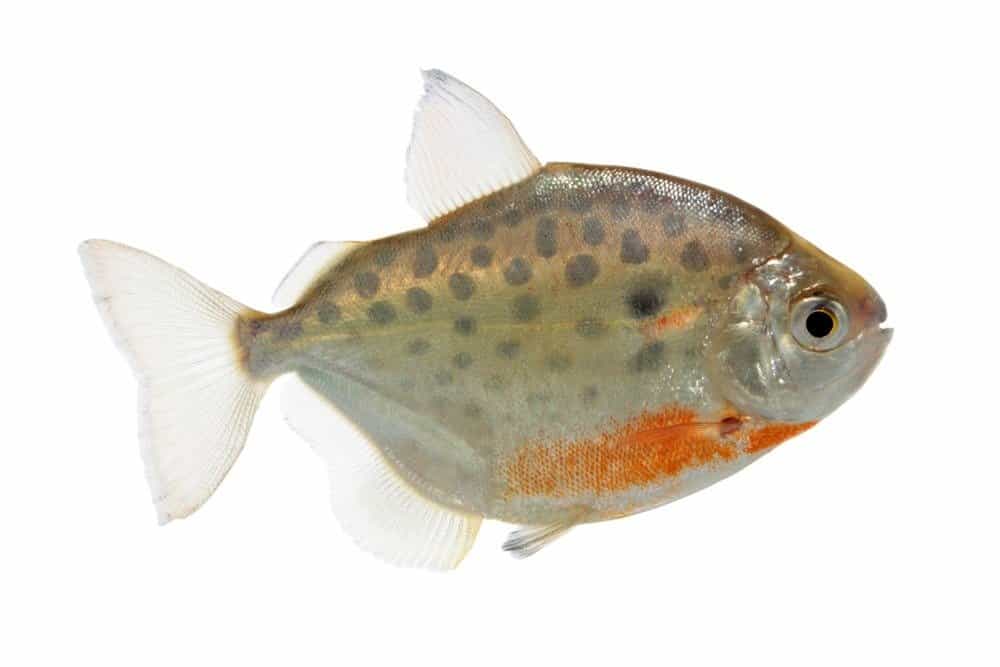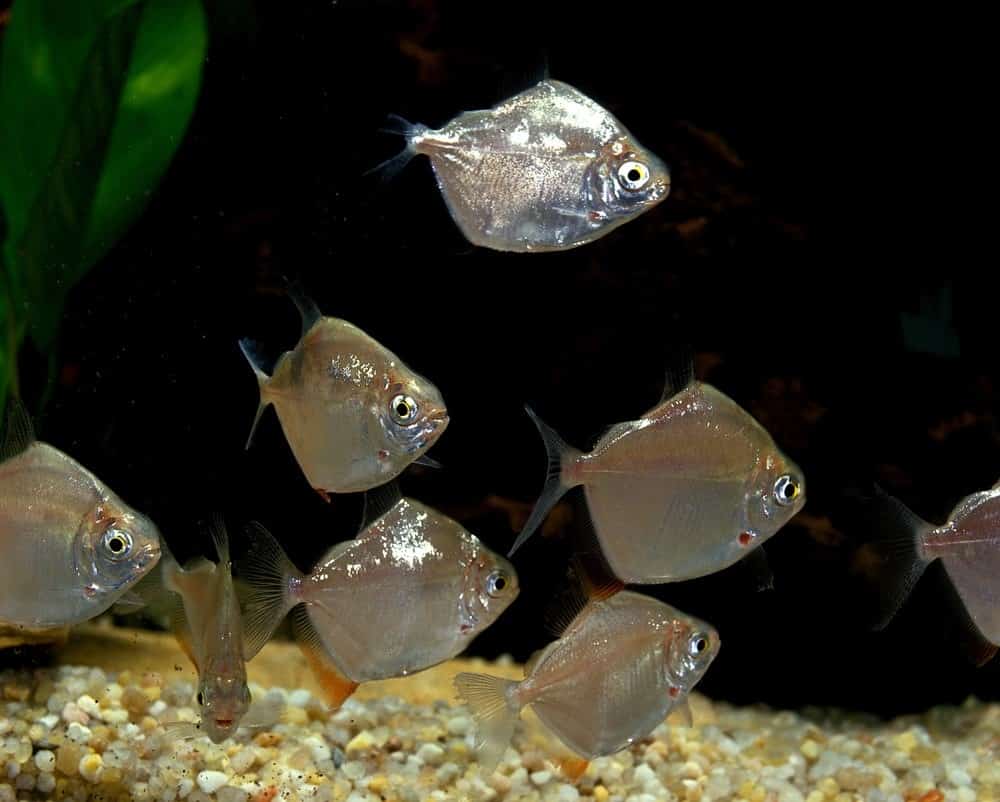If you are a silver dollar fish enthusiast, then this comprehensive guide is for you. We will delve into the world of silver dollar fish, explain the differences between the types, and provide tips on how to select, breed, and care for your fish.
Overview of Silver Dollar Fish

©You Touch Pix of EuToch/Shutterstock.com
Silver dollar fish are part of the Characidae family and are native to South America. These peaceful schooling fish are popular among aquarium hobbyists due to their unique shape and shimmering appearance.
These fish originate from the rivers and streams of South America. They prefer slow-moving waters with plenty of vegetation, which they mimic in aquarium settings.
In terms of appearance, silver dollar fish are aptly named for their round, flat bodies that resemble a silver coin. They typically grow to around 6 inches in length and have a lifespan of up to 10 years in captivity.
Their behavior is generally peaceful and social. They enjoy schooling with their own kind and usually spend most of their time at the top or middle layers of the water column.
Five Types of Silver Dollar Fish

©Marcelo Saavedra/Shutterstock.com
Tiger Silver Dollar Fish
The Tiger Silver Dollar is distinguished by its striking dark stripes across its body. It is a lovely silver and blue color that shimmers in the water. This breed is slightly more aggressive than other types but remains a suitable choice for community tanks. This species thrives in densely planted aquariums with plenty of hiding spots. They prefer a diet rich in vegetables but will also consume a variety of live or frozen foods like bloodworms and shrimp.
Spotted Silver Dollar Fish
As the name suggests, Spotted Silver Dollar Fish are characterized by their unique spotted pattern. These peaceful fish are perfect for community aquariums with other non-aggressive species. They require large tanks with plenty of plants and driftwood to mimic their natural habitat. Their diet consists mainly of plant matter, but they will also eat meaty foods.
Red Hook Silver Dollar Fish
The Red Hook Silver Dollar Fish is known for its distinctive red dorsal fin hook. The remainder of its body is silver, though some have patches of red. This species is relatively peaceful and social, making it suitable for larger community tanks. Similar to other types, they appreciate planted tanks with enough swimming space. Their diet should include a mix of vegetable-based foods and protein-rich foods.
Black Bar Silver Dollar Fish
Black Bar Silver Dollar Fish stands out with its vertical black bars across its body. It is a peaceful species that does well in community tanks. They are four inches long and have a kite-shaped body. This species requires a similar environment as the others – large tanks with plenty of plants. Their preferred diet includes both plant-based foods and meaty treats.
Common Silver Dollar Fish
The Common Silver Dollar Fish is the most recognized type among hobbyists because of its bright silver coloration. It’s a peaceful and social species ideal for community aquariums. Adults are between six and eight inches long. A spacious tank with dense vegetation is ideal for this type. As omnivores, they enjoy a diet that includes both plant-based foods and meaty proteins.
Selecting Your Silver Dollar Fish
When selecting your silver dollar fish, it is essential to take into account several factors that will contribute to their overall well-being and compatibility with other aquatic companions. One crucial consideration is the appropriate tank size for these magnificent creatures. Silver dollar fish thrive in spacious environments where they can freely swim and explore their surroundings. Therefore, it is recommended to provide them with a larger aquarium that offers ample swimming space.
Additionally, ensuring the compatibility of your silver dollar fish with other species residing in the same tank is vital for maintaining a harmonious aquatic community. These peaceful herbivores generally get along well with similarly sized and non-aggressive fish breeds. However, it would be best to avoid housing them alongside fin-nipping or aggressive counterparts that may disrupt their serene nature.
While examining potential candidates for your collection, it’s important to select active individuals indicative of good physical condition. Vibrant and lively silver dollar fish are more likely to adapt seamlessly into their new habitat while displaying natural behaviors inherent to their species. Furthermore, observe their eyes closely. Clear eyes indicate healthy vision capabilities necessary for navigating through intricate underwater landscapes.
Breeding Silver Dollar Fish

©Kazakov Maksim/Shutterstock.com
Silver dollar fish breed through egg scattering during the rainy season in their natural habitat. To encourage breeding in captivity, provide a large tank with soft water, plenty of plants, and a varied diet.
Raising 6 or more juvenile silver dollar fish for a year will help them reach maturity. To boost breeding success, separate the males and females for a week or two before mating and feed them high-quality food.
To breed silver dollar fish, it’s best to take a pair out of the school and put them in a tank of their own. The tank size should be 40 to 50 gallons, and the water temperature should be between 80F and 82F. Dim lighting and plastic leaf plants should also be added. The female can lay up to 2,000 eggs! Those eggs will hatch in three days, and the guppies will be ready to eat store-bought fry food or snack on brine shrimp after only seven days.
Caring for Your Silver Dollar Fish
Silver dollars prefer warm water (75-82°F), water pH (6-7), and soft to moderately hard water hardness (4-8 dGH). Provide them with plenty of plants and driftwood to make them feel secure.
Silver dollar fish require 75 gallons of water per each five fish, so be sure not to overcrowd them. Change the water at intervals to keep it fresh and clean.
To keep your silver dollar fish stress free, it’s best to reduce the light in the room and keep the pH levels between 5 and 7. If your water is too hard, you can use reverse osmosis or aquarium peat to lower the hardness. If you need to harden the water, you should add calcium-based rocks to your tank. The ideal hardness measure for silver dollar fish is between 4 and 8 dH.
Partial water changes of up to 25 percent of the water are advised every two weeks to ensure the health of your silver dollar fish. If you are using unfiltered tap water, make sure to test its pH and hardness levels before adding it to the tank in order to maintain optimal conditions.
Diet
Silver dollar fish are not particular when it comes to their diet. Vegetable flake food, leafy greens, algae wafers, cooked spinach, and other cooked vegetables such as peas and squash can all be enjoyed. However, if you’re serving fresh food, make sure to remove any uneaten portions, as it can contaminate the tank and lead to health issues. Additionally, silver dollar fish also enjoy meaty treats such as bloodworms, brine shrimp, and larvae. A two-times-a-day feeding schedule is best for optimal health.
Diseases

©slowmotiongli/Shutterstock.com
Silver dollar fish are relatively simple to maintain compared to other fish and are not prone to any species-specific diseases. However, they can be vulnerable to various common freshwater aquarium illnesses, such as ich, fungal diseases, parasites, or bacteria. Additionally, blackspot and black ick, caused by a parasite that embeds itself in their skin, is something to watch out for. Constipation may also occur in silver dollar fish due to their flat body shape; increasing fiber in their diet is the best way to treat this.
Fungal infections are a common occurrence in freshwater tanks but can be easily treated with store-bought medication. To prevent such diseases, it is important to keep your tank clean, clear, and aerated. Providing your silver dollar fish with a healthy diet will also help to avoid any health issues from arising in the tank.
10 Tank Mates for Silver Dollar Fish
Silver dollar fish are a good choice for tanks with multiple fish, as they are tranquil and peaceful. They tend to swim close to the surface, so bottom-feeding fish are best for companionship. When picking out tank mates for your silver dollar fish, make sure they can handle the same water conditions. Additionally, it is best to avoid smaller breeds of fish, such as bettas and neon tetras, as they may be mistaken as food by the silver dollar fish due to their size and strength.
| Number | Tanks Mates for Silver Dollar Fish |
|---|---|
| 1 | Bala fish |
| 2 | Pacu |
| 3 | Goldfish |
| 4 | Danios |
| 5 | Plecos |
| 6 | Cichlids |
| 7 | Cory Catfish |
| 8 | Bristlenose |
| 9 | Kuhli Loaches |
| 10 | Doradids |
Up Next:
"fish" - Google News
July 16, 2023 at 11:48AM
https://ift.tt/vcbNiLg
5 Types of Silver Dollar Fish: A Guide on Selecting, Breeding and Caring For Your Fish - AZ Animals
"fish" - Google News
https://ift.tt/NvmkbEK
https://ift.tt/x1DqcAB
Bagikan Berita Ini














0 Response to "5 Types of Silver Dollar Fish: A Guide on Selecting, Breeding and Caring For Your Fish - AZ Animals"
Post a Comment